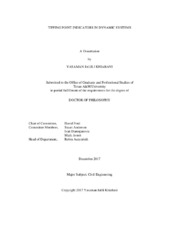| dc.description.abstract | Many complex systems have a tipping point after which the system suddenly shifts to a qualitatively different state. This large, abrupt, and often irreversible change in the behavior makes their management challenging. Predicting when a system is near, at or beyond a tipping point is important in system design and management. The similarities in system behaviors raise the question whether there are generic indicators of tipping points. Although, “critical slowing down” is the most studied tipping point indicator suggested in the literature, the usefulness of this indicator in real systems is still under investigation. To transition from simple math models to the application of tipping point indicators in practice, a library of system dynamics models with tipping points was developed. Model complexity ranges from simple archetypes to more complex and realistic models. The library models were used to develop an improved definition of a tipping point and to study the underlying system structures that create a tipping point. Two tipping point types were identified: (1) change in the dominance of feedback loops, and (2) change in the direction of the dominant reinforcing loop. Testing the “slowing down” measures in the library models demonstrated and supported the importance of these indicators in identifying tipping points. Investigating the similarities in the system behaviors before the tipping point resulted in two new potential indicators: (1) distance of system conditions on a xˇt+1-xˇt graph, and (2) slope of a xˇt+1-x ˇt graph. The proposed indicators are more practical and easier to use in the construction management field. The findings highlight some limitations: the clarity of the indicator signal depends on the complexity of the system, presence of noise in the system, and the time frame of the study. | en |


